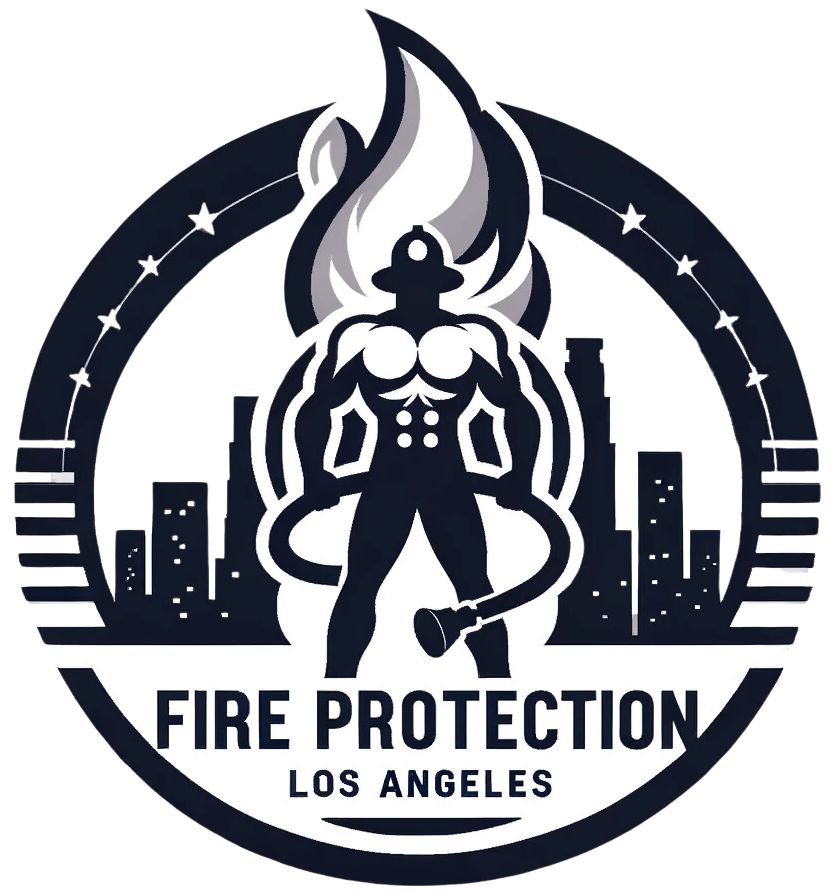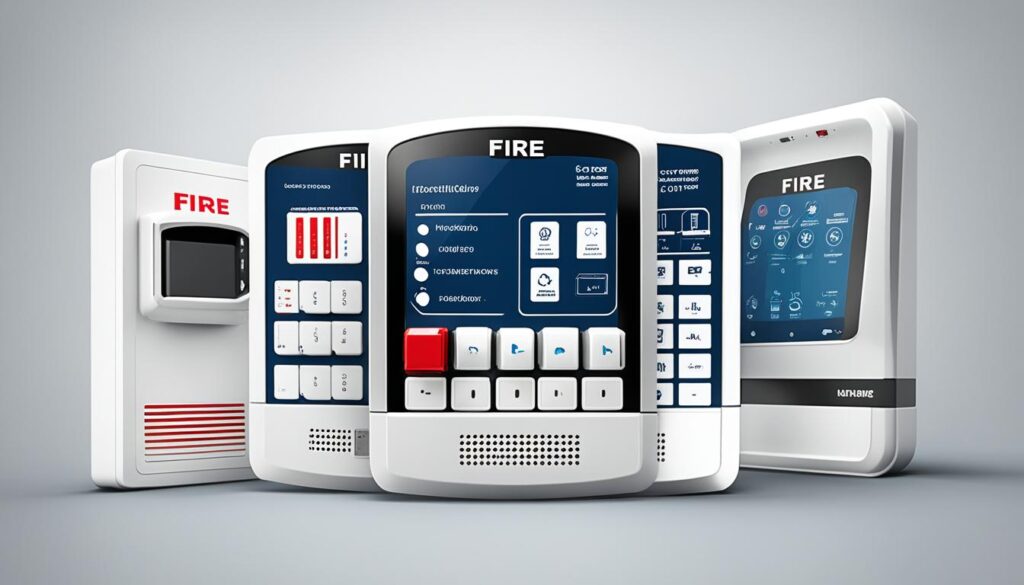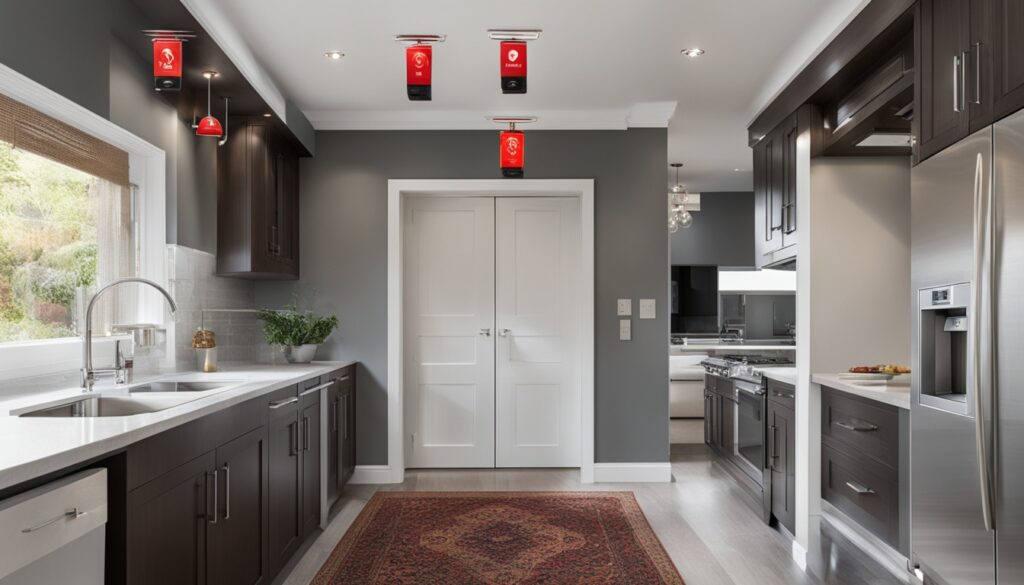Almost two-thirds of home fire deaths happen in homes without working smoke alarms. This shows how crucial it is to choose the best fire alarm. Most of these deaths occur at night, when people are asleep. To keep homes safe, learning about fire detection technology is key.
Smoke alarms are common in homes but are more complex than we think. There are different types like ionization alarms and photoelectric detectors. Experts say using both kinds or dual-sensor alarms is best for safety.
Choosing the right home safety devices is very important. It’s not just about picking alarms. It also means installing and maintaining them well. Make sure alarms are put in every level of your home and near sleeping areas. Test them monthly and replace batteries yearly to keep your home safe.
Choosing between ionization and photoelectric detectors needs careful thought. Each type has its own rules, like not using ionization alarms in damp places like bathrooms. Alarms should be replaced every ten years, even if they seem to work fine.
Buying home safety devices might seem expensive, but some fire departments offer them for less or even free. This makes it easier for people to get the safety they need. Understanding fire alarm installation and maintenance is important. It helps you pick the right system for your home.
You can choose from simple battery-powered alarms or smart alarms that talk to each other. There are many options for different needs and budgets. Each choice means you’ll have alarms ready to help you and your family in an emergency.
Understanding Different Types of Fire Alarm Systems
Choosing the right fire alarm system is key for safety and following local laws. This part looks at the different types of fire alarms. It talks about their technologies and benefits.
Ionization vs. Photoelectric Smoke Detectors
Ionization and photoelectric smoke detectors have different jobs and work well in various situations. Ionization smoke detectors catch small smoke particles from fast fires. They use a tiny bit of radioactive stuff to sense changes in air, which makes them quick to alarm.
Photoelectric smoke detectors are better at catching big smoke particles from slow fires. They have a light beam that breaks when smoke gets in the way, setting off the alarm. Both types are important for a full fire safety plan.
The Benefits of Dual-Sensor Fire Alarms
Dual-sensor fire alarms use both ionization and photoelectric smoke detection. This means they can spot both fast and slow fires. They’re a great pick for keeping homes safe from fires.
Wireless Fire Alarms and Smart Technologies
New tech has brought us wireless fire alarms and smart home fire alarms. These are easy to set up and work well with other smart home gadgets. They can send alerts to your phone about fires or when the battery needs changing.
Key Features of Modern Fire Detection Technology
Today’s fire detection systems do more than just make a noise. They’re reliable, connected, and smart. They can be checked remotely, work with other smart devices, and check themselves to keep working right. They also try to avoid false alarms, which old systems often had.
Assessing Your Home’s Specific Fire Alarm Needs
Keeping your home safe means more than just picking the right fire alarms. It’s about a detailed plan for your home’s layout and risks. By looking at fire hazards, thinking about your home’s design, and planning where to put alarms, you can make your home safer in emergencies.
Evaluating Potential Fire Hazards Within Your Home
First, check for fire risks like old wiring, flammable stuff, and places you might miss like attics or basements. Look at appliances that get hot or use a lot of power too. This helps you know what kind of fire alarms you need, especially if your home is big or has special designs.
Considering the Size and Layout of Your Home
- Single-story homes might need fewer alarms, but make sure they’re in all sleeping and main living areas.
- Bigger homes or those with more stories need more alarms. Think about ones that make all alarms go off at once, so you know it’s an emergency anywhere in the house.
Think about what your family needs, like alarms for the hearing-impaired or easy-to-use manual ones for older folks.
The Importance of Fire Alarm Placement
- Put smoke alarms at the top and bottom of stairs. Heat and smoke go up, so alarms here can catch them early.
- Every bedroom should have its own smoke alarm, especially if doors are closed at night.
- Don’t put alarms near windows, doors, or vents. Drafts can mess with how they work.
- Stay away from places with a lot of moisture or dust. These can cause false alarms or harm the alarms.
By planning where to put alarms and knowing your home’s layout and risks, you make sure your alarms meet your home’s needs. This way, if there’s a fire, you’re much safer and your home is protected better.
Installation and Maintenance of Home Safety Devices
Putting in fire alarms right is key to keeping your home safe. The NFPA says you should have smoke detectors on every floor, in bedrooms, and at the basement stairs. This helps fight home fires, which often start from cooking. In 2021, there were about 170,000 home fires in the U.S.
When smoke detectors work well, they cut the risk of dying in a fire by half. Make sure to follow the maker’s instructions and local safety rules when installing them. This can save lives.
Keeping fire alarms in good shape is important too. The U.S. Fire Administration says test them every month and change the batteries yearly. Dust can block smoke detectors, so clean them every year. Some alarms can connect to each other and send alerts to your phone. They also tell you when the battery is low.
For people who can’t see or hear well, there are special alarms with lights and sounds. These help everyone in the house know when there’s a fire.
The NFPA says to replace smoke alarms every 10 years. This includes alarms with a 10-year battery that you replace when it signals the end. You can choose from different types of alarms, but keep up with their maintenance. Experts suggest using alarms that catch different kinds of fires.
Also, put fire extinguishers around your home, like a 2-A:10-B-C rated one. This kind of extinguisher is good for fighting many fires. It helps protect your home from fires.










